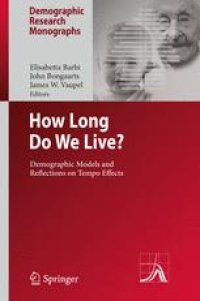
Ebook: How Long Do We Live?: Demographic Models and Reflections on Tempo Effects
- Tags: Demography, Population Economics, Aging, Statistics for Social Science Behavorial Science Education Public Policy and Law
- Series: Demographic Research Monographs
- Year: 2008
- Publisher: Springer-Verlag Berlin Heidelberg
- Edition: 1
- Language: English
- pdf
The most widely used measure of longevity is the period life expectancy at birth which is calculated from age specific death rates by life table methods. In 2002, John Bongaarts and Griffith Feeney introduced the revolutionary idea that this conventional estimate of period life expectancy is distorted by a tempo effect whenever longevity is changing. The tempo effect is defined as an inflation or deflation of the period incidence of a demographic event resulting from a rise or fall in the mean age at which the event occurs. Some demographers agree with this radical argument; others disagree. The book reviews the debate on how best to measure period longevity. In the various chapters, leading experts in demography critically examine the existence of the tempo effect in mortality, present extensions and applications, and compare period and cohort longevity measures. The book provides a deeper understanding of and new insights into the fundamental question "How long do we live"?
The most widely used measure of longevity is the period life expectancy at birth which is calculated from age specific death rates by life table methods. In 2002, John Bongaarts and Griffith Feeney introduced the revolutionary idea that this conventional estimate of period life expectancy is distorted by a tempo effect whenever longevity is changing. The tempo effect is defined as an inflation or deflation of the period incidence of a demographic event resulting from a rise or fall in the mean age at which the event occurs. Some demographers agree with this radical argument; others disagree. The book reviews the debate on how best to measure period longevity. In the various chapters, leading experts in demography critically examine the existence of the tempo effect in mortality, present extensions and applications, and compare period and cohort longevity measures. The book provides a deeper understanding of and new insights into the fundamental question "How long do we live"?
The most widely used measure of longevity is the period life expectancy at birth which is calculated from age specific death rates by life table methods. In 2002, John Bongaarts and Griffith Feeney introduced the revolutionary idea that this conventional estimate of period life expectancy is distorted by a tempo effect whenever longevity is changing. The tempo effect is defined as an inflation or deflation of the period incidence of a demographic event resulting from a rise or fall in the mean age at which the event occurs. Some demographers agree with this radical argument; others disagree. The book reviews the debate on how best to measure period longevity. In the various chapters, leading experts in demography critically examine the existence of the tempo effect in mortality, present extensions and applications, and compare period and cohort longevity measures. The book provides a deeper understanding of and new insights into the fundamental question "How long do we live"?
Content:
Front Matter....Pages I-XIII
How long do we live? Demographic models and reflections on tempo effects: An introduction....Pages 1-8
Front Matter....Pages 9-9
Estimating mean lifetime....Pages 11-27
The quantum and tempo of life-cycle events....Pages 29-65
Front Matter....Pages 67-67
Demographic translation and tempo effects: An accelerated failure time perspective....Pages 69-92
Lifesaving, lifetimes and lifetables....Pages 93-107
Tempo and its tribulations....Pages 109-128
Tempo effects in mortality: An appraisal....Pages 129-152
Increments to life and mortality tempo....Pages 153-165
Mortality tempo versus removal of causes of mortality: Opposite views leading to different estimations of life expectancy....Pages 167-189
Tempo effect on age-specific death rates....Pages 191-201
Mortality tempo-adjustment: Theoretical considerations and an empirical application....Pages 203-233
Front Matter....Pages 235-235
Five period measures of longevity....Pages 237-245
Found in translation? A cohort perspective on tempo-adjusted life expectancy....Pages 247-259
Front Matter....Pages 261-261
Afterthoughts on the mortality tempo effect....Pages 263-269
Turbulence in lifetables: Demonstration by four simple examples....Pages 271-279
Back Matter....Pages 281-284
The most widely used measure of longevity is the period life expectancy at birth which is calculated from age specific death rates by life table methods. In 2002, John Bongaarts and Griffith Feeney introduced the revolutionary idea that this conventional estimate of period life expectancy is distorted by a tempo effect whenever longevity is changing. The tempo effect is defined as an inflation or deflation of the period incidence of a demographic event resulting from a rise or fall in the mean age at which the event occurs. Some demographers agree with this radical argument; others disagree. The book reviews the debate on how best to measure period longevity. In the various chapters, leading experts in demography critically examine the existence of the tempo effect in mortality, present extensions and applications, and compare period and cohort longevity measures. The book provides a deeper understanding of and new insights into the fundamental question "How long do we live"?
Content:
Front Matter....Pages I-XIII
How long do we live? Demographic models and reflections on tempo effects: An introduction....Pages 1-8
Front Matter....Pages 9-9
Estimating mean lifetime....Pages 11-27
The quantum and tempo of life-cycle events....Pages 29-65
Front Matter....Pages 67-67
Demographic translation and tempo effects: An accelerated failure time perspective....Pages 69-92
Lifesaving, lifetimes and lifetables....Pages 93-107
Tempo and its tribulations....Pages 109-128
Tempo effects in mortality: An appraisal....Pages 129-152
Increments to life and mortality tempo....Pages 153-165
Mortality tempo versus removal of causes of mortality: Opposite views leading to different estimations of life expectancy....Pages 167-189
Tempo effect on age-specific death rates....Pages 191-201
Mortality tempo-adjustment: Theoretical considerations and an empirical application....Pages 203-233
Front Matter....Pages 235-235
Five period measures of longevity....Pages 237-245
Found in translation? A cohort perspective on tempo-adjusted life expectancy....Pages 247-259
Front Matter....Pages 261-261
Afterthoughts on the mortality tempo effect....Pages 263-269
Turbulence in lifetables: Demonstration by four simple examples....Pages 271-279
Back Matter....Pages 281-284
....